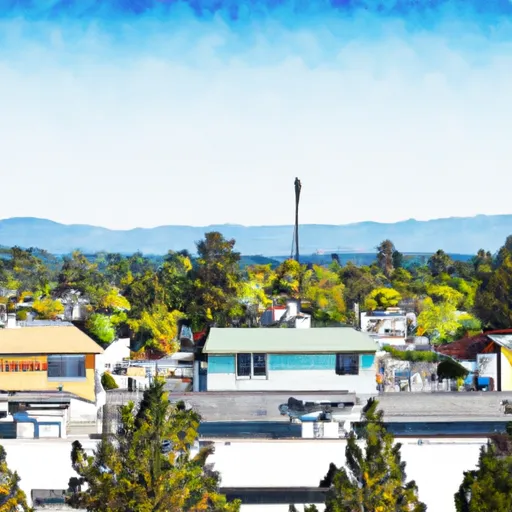-
 Snoflo Premium
Snoflo Premium
Get unlimited access to all our content
With no Ad interruptions! - Start Your Free Trial Login with existing account
River-Pines
Eden Index
Climate
9.8
•
Recreation
5.1
•
Community
•
Safeguard
5.7/10

River Pines, California is a small census-designated place located in Amador County, nestled in the beautiful Sierra Nevada foothills. The region experiences a Mediterranean climate with hot, dry summers and mild, wet winters. Summers in River Pines are typically sunny and warm, with temperatures reaching the upper 90s (°F).
The area is rich in hydrology constituents, with the Mokelumne River flowing nearby. The river is a vital water source for the region, with its clear waters attracting visitors for various recreational activities like fishing, kayaking, and swimming. The river's hydrology also supports diverse wildlife and scenic landscapes along its banks.
Outdoor enthusiasts will find plenty of opportunities in River Pines and its surroundings. The area boasts numerous hiking trails, including portions of the Pacific Crest Trail, offering stunning vistas and a chance to explore the local flora and fauna. Nearby lakes and reservoirs, such as Lake Amador and Pardee Reservoir, provide additional recreation options like boating, water skiing, and camping.
In conclusion, River Pines is a picturesque community with a Mediterranean climate, a rich hydrology system, and abundant outdoor recreation opportunities for nature lovers and adventure seekers alike.
What is the Eden Index?
The Snoflo Eden Index serves as a comprehensive rating system for regions, evaluating their desirability through a holistic assessment of climate health, outdoor recreation opportunities, and natural disaster risk, acknowledging the profound impact of these factors on livability and well-being.
Climate Health Indicator (CHI): 9.8
River-Pines receives approximately
947mm of rain per year,
with humidity levels near 75%
and air temperatures averaging around
15°C.
River-Pines has a plant hardyness factor of
9, meaning
plants and agriculture in this region tend to thrive here all year round.
By considering the ideal temperature range, reliable water supplies, clean air, and stable seasonal rain or snowpacks, the Climate Health Indicator (CHI) underscores the significance of a healthy climate as the foundation for quality living.
A healthy climate is paramount for ensuring a high quality of life and livability in a region, fostering both physical well-being and environmental harmony. This can be characterized by ideal temperatures, reliable access to water supplies, clean air, and consistent seasonal rain or snowpacks.
Weather Forecast
Streamflow Conditions
San Joaquin
Area Rivers
San Joaquin
Snowpack Depths
San Joaquin
Reservoir Storage Capacity
San Joaquin
Groundwater Levels
Recreational Opportunity Index (ROI): 5.1
The Recreational Opportunity Index (ROI) recognizes the value of outdoor recreational options, such as parks, hiking trails, camping sites, and fishing spots, while acknowledging that climate plays a pivotal role in ensuring the comfort and consistency of these experiences.
Access to outdoor recreational opportunities, encompassing activities such as parks, hiking, camping, and fishing, is crucial for overall well-being, and the climate plays a pivotal role in enabling and enhancing these experiences, ensuring that individuals can engage in nature-based activities comfortably and consistently.
Camping Areas
| Campground | Campsites | Reservations | Toilets | Showers | Elevation |
|---|---|---|---|---|---|
| Deerwood - Sly Park Recreation Area | None | 3,622 ft | |||
| Ponderosa Cove | 18 | 4,293 ft | |||
| Pine Cone - Sly Park Recreation Area | None | 3,488 ft | |||
| Hazel Creek - Sly Park Recreation Area | None | 3,548 ft | |||
| Stumpy Meadows | 40 | 4,465 ft | |||
| Rainbow - Sly Park Recreation Area | None | 3,579 ft | |||
| Finnon Lake | 14 | 2,427 ft | |||
| Rucky A Chucky - Auburn State Rec Area | 5 | 723 ft | |||
| Sly Park | 191 | 3,596 ft | |||
| Dru Barner | 47 | 3,237 ft |
Nearby Ski Areas
Catastrophe Safeguard Index (CSI):
The Catastrophe Safeguard Index (CSI) recognizes that natural disaster risk, encompassing floods, fires, hurricanes, and tornadoes, can drastically affect safety and the overall appeal of an area.
The level of natural disaster risk in a region significantly affects safety and the overall livability, with climate change amplifying these risks by potentially increasing the frequency and intensity of events like floods, fires, hurricanes, and tornadoes, thereby posing substantial challenges to community resilience and well-being.
Community Resilience Indicator (CRI):
The Community Resilience Indicator (CRI) recognizes that education, healthcare, and socioeconomics are crucial to the well-being of a region. The CRI acknowledges the profound impact of these elements on residents' overall quality of life. By evaluating educational resources, healthcare accessibility, and economic inclusivity, the index captures the essential aspects that contribute to a thriving community, fostering resident satisfaction, equity, and social cohesion.

